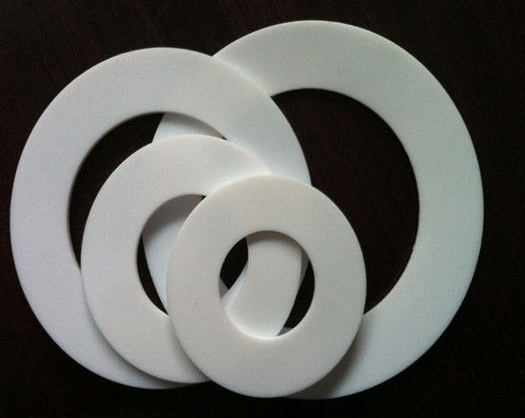- 13
- Nov
Junta de PTFE
Junta de PTFE
PTFE gaskets have excellent properties of creep resistance, cold flow resistance, ultra-low temperature resistance, no pollution, and easy installation and disassembly. Under a small pre-tightening force, it can withstand considerable internal pressure even in a pressure fluctuation environment. It is very suitable for rough or unevenly worn and fragile glass-faced flanges and temperature-changing sealing occasions. We can choose Gore, Klinger, Garlock, Sealon and other expanded PTFE sheets for customers to produce the required gaskets for customers.
competitiva
Resistencia a altas temperaturas: la temperatura de trabajo puede alcanzar los 250 ℃.
Resistencia a bajas temperaturas: tiene buena tenacidad mecánica; incluso si la temperatura desciende a -196 ℃, puede mantener un 5% de alargamiento.
Resistencia a la corrosión: es inerte a la mayoría de los productos químicos y disolventes, y puede soportar ácidos y álcalis fuertes, agua y varios disolventes orgánicos.
Weather resistance-has excellent aging life in plastics.
High lubrication-is the low coefficient of friction in solid materials.
Non-adhesion-it means that the surface tension in the solid material is small and does not adhere to any substance. Its mechanical properties have a very small friction coefficient, which is only 1/5 of that of polyethylene. This is an important feature of the perfluorocarbon surface. In addition, because the fluorine-carbon chain intermolecular forces are extremely low, PTFE is non-sticky.
Non-toxic and harmful-with physiological inertia, as an artificial blood vessel and organ implanted in the body for a long time without adverse reactions.
Propiedades eléctricas El politetrafluoroetileno tiene baja constante dieléctrica y pérdida dieléctrica en un amplio rango de frecuencia, y tiene alto voltaje de ruptura, resistividad de volumen y resistencia al arco.
Radiation resistance Polytetrafluoroethylene has poor radiation resistance (104 rad), and it degrades after being exposed to high-energy radiation, and the electrical and mechanical properties of the polymer are significantly reduced. Application Polytetrafluoroethylene can be formed by compression or extrusion processing; it can also be made into water dispersion for coating, dipping or making fibers. PTFE is widely used as high and low temperature resistant, corrosion resistant materials, insulating materials, anti-stick coatings, etc. in nuclear energy, aerospace, electronics, electrical, chemical, machinery, instruments, meters, construction, textiles, food and other industries.
Resistencia al envejecimiento atmosférico: resistencia a la radiación y baja permeabilidad: exposición prolongada a la atmósfera, la superficie y el rendimiento permanecen sin cambios.
No combustibilidad: el índice límite de oxígeno está por debajo de 90.
Resistencia a ácidos y álcalis: insoluble en ácidos fuertes, álcalis fuertes y disolventes orgánicos.
Resistencia a la oxidación: resistente a la corrosión por oxidantes fuertes.
Acidez: Neutro.
Las propiedades mecánicas del PTFE son relativamente suaves. Tiene una energía superficial muy baja.
Polytetrafluoroethylene (F4, PTFE) has a series of excellent performance: high temperature resistance-long-term use temperature of 200~260 degrees, low temperature resistance-still soft at -100 degrees; corrosion resistance-resistance to aqua regia and all organic solvents; Weather resistance-aging life in plastics; high lubrication-with a small coefficient of friction (0.04) in plastics; non-stickiness-with low surface tension in solid materials without adhesion of any substances; non-toxic-with physiological inertness; excellent electrical properties , Is an ideal C-level insulating material.

